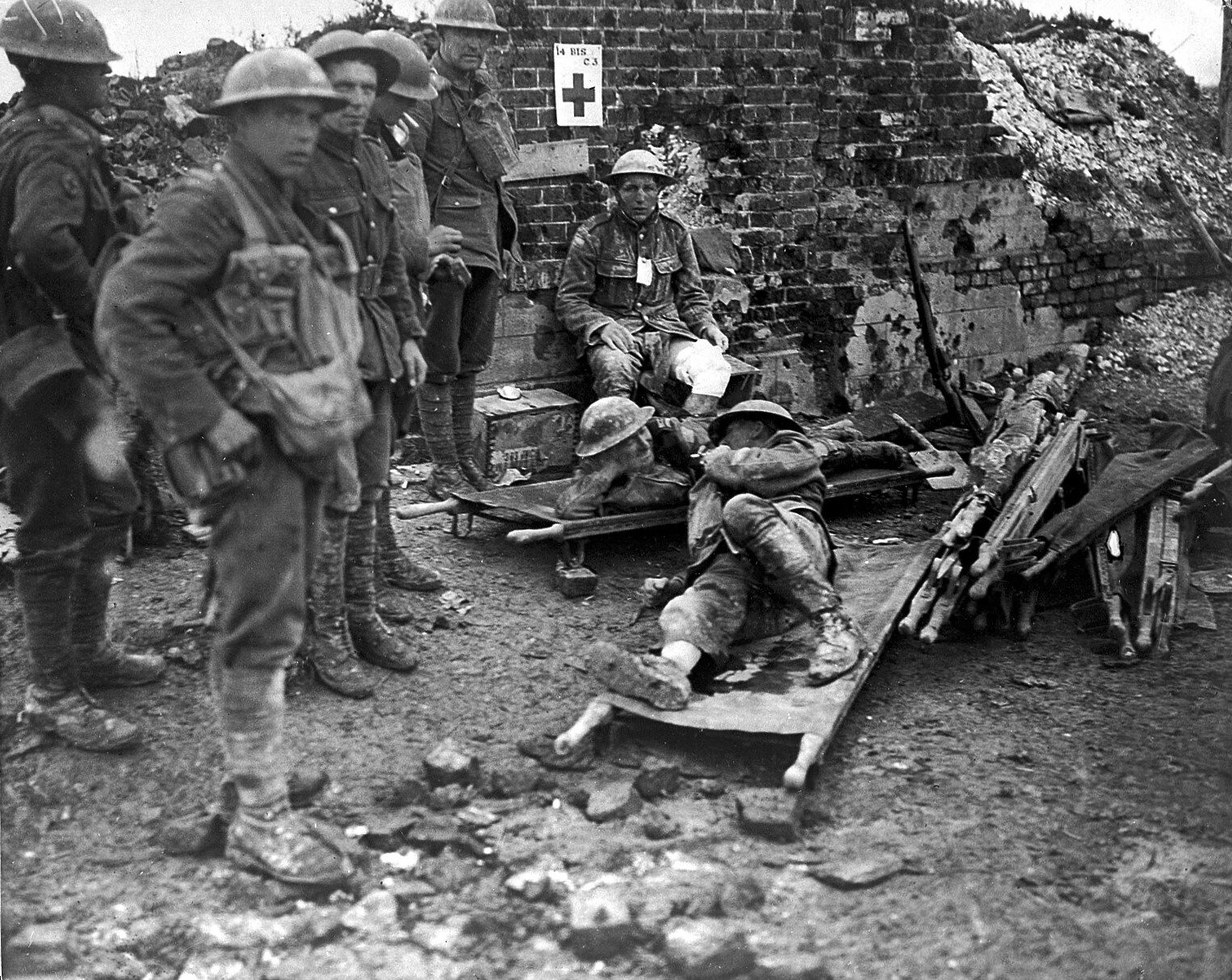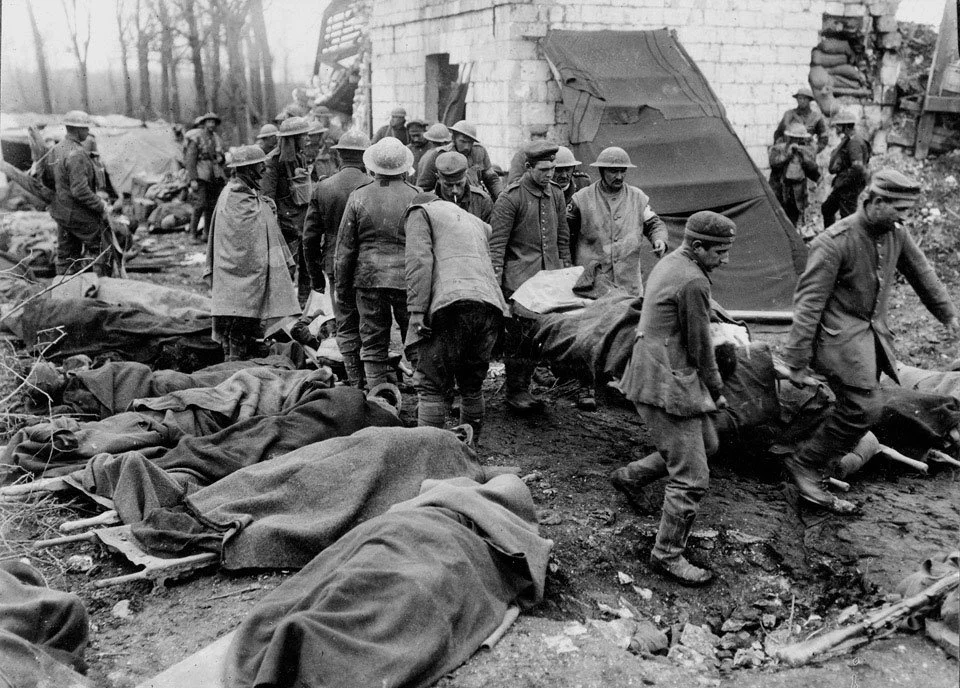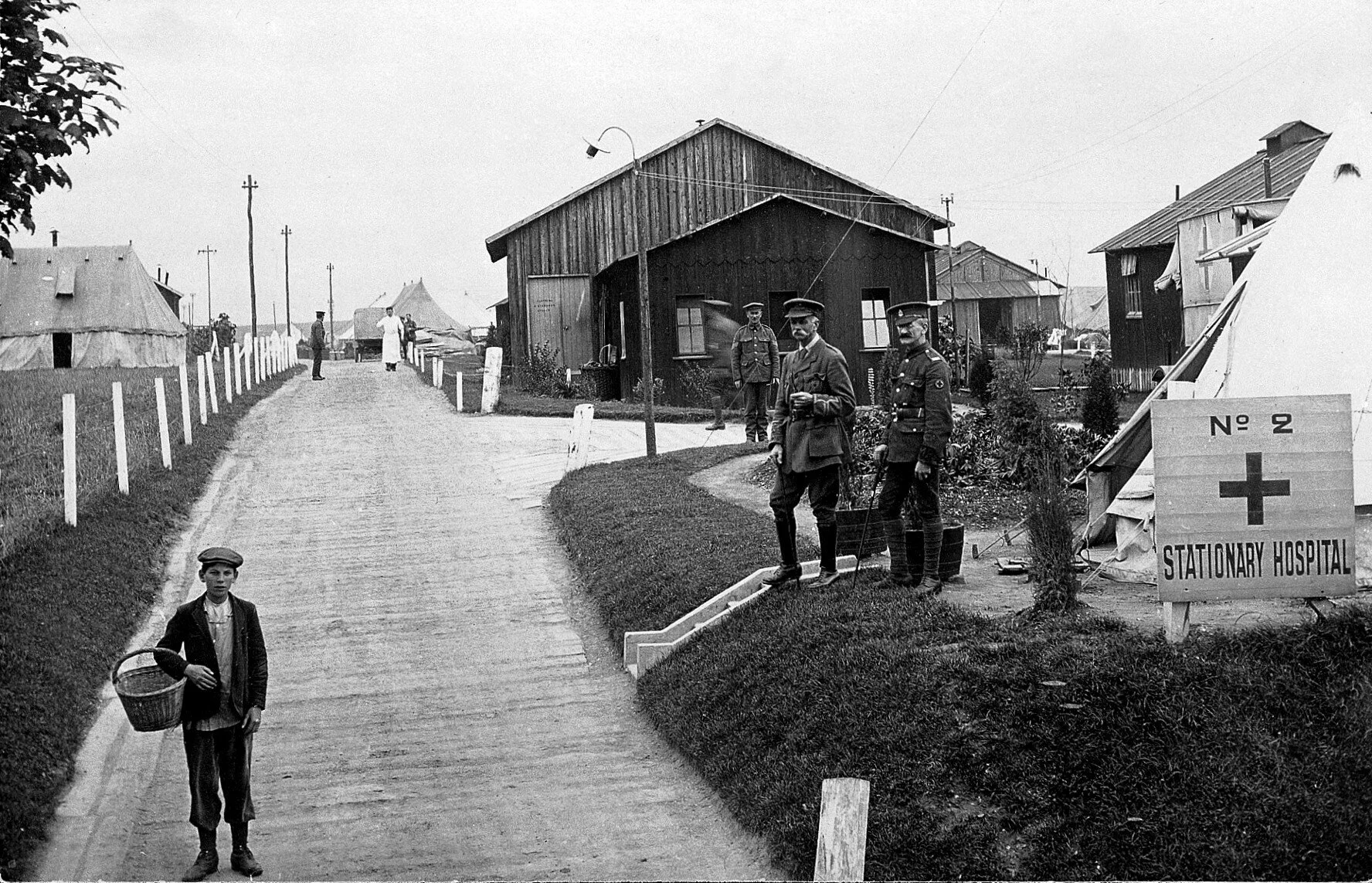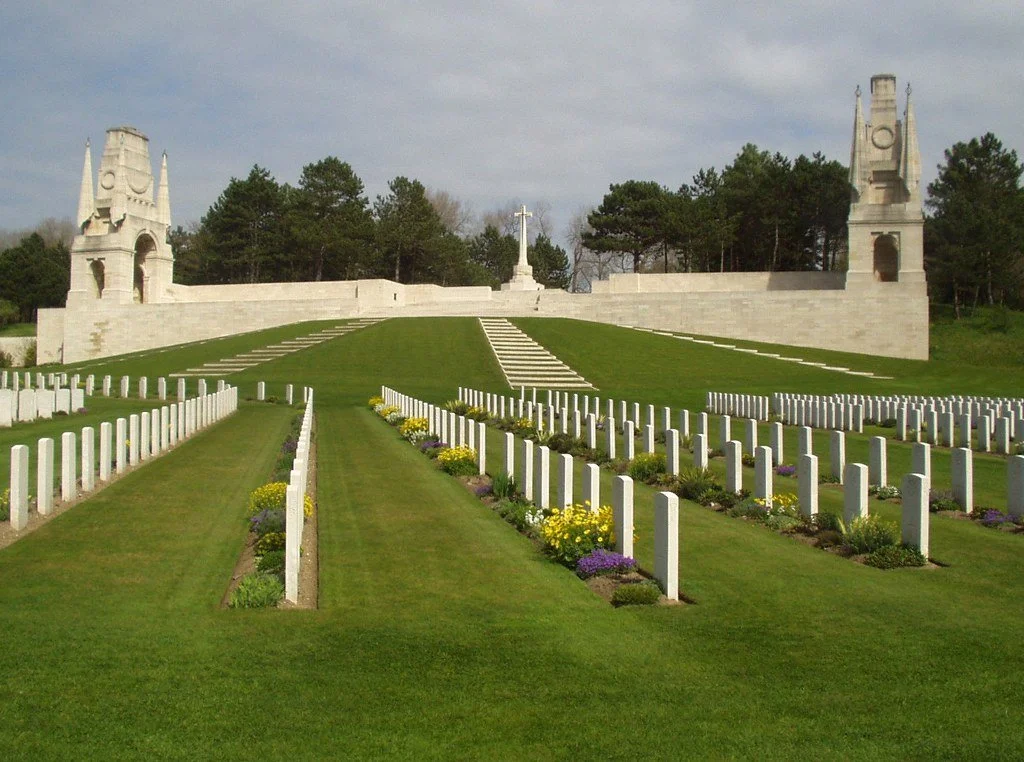Thomas Davies, Private, 31st Battalion Machine Gun Corps
Thomas Davies was born in 1894 in Moreton-on-Lugg, Herefordshire.
In the 1901 census, he is living with his parents, Thomas Davies (37), Eliza Davies (40) and a younger sister and brother at Yazor, Herefordshire in a four room (including kitchen) dwelling. His father is a waggoner on farm. A waggoner was entirely responsible for care of horses under his control and attended to the watering, feeding and bedding of the horses as well as harnessing them and driving them in accordance with whatever work was to be undertaken - ploughing, reaping, harrowing and carting.
Thomas Davies’s father had been born in Kentchester, Herefordshire, his mother having been born in Shobdon. Thomas Davies’s brother who was two years younger than Thomas was born in Canon Pyon while the youngest, the daughter Alice, was born in Whitney. So, it might indicate that the family had been moving around on a frequent basis.
In the 1911 census, Thomas Davies is working as an “under waggoner on farm” - a second carter or younger man who does work in connection with horses as carter similar to a waggoner but who is under the supervision of the carter.
As an under waggoner, Thomas Davies is employed by a farmer and hop grower, William Bishop, who is married with two young children. The address is Field’s Place, Dilwyn.
On 5th August, 1914, Thomas Davies marries Elsie Jones. Two months later, a son, William Thomas, is born and then on 5th April 1917, a daughter, Sybil Alice.
On 11th February 1916 Thomas Davies, according to the Short Service of Attestation documents, enlists in the 4th Battalion, King’s Shropshire Light Infantry at Leominster for the duration of the war. On the date of enlistment, Thomas Davies’s occupation, prior to this date, was that of “cowman” and he, his wife and first child are listed as living at Windsor Cottage, Dilwyn.
Above photo: Windsor Cottage, Dilwyn today (1)
By now, the pressure to enlist in the army was ratcheting up.
“In autumn 1915, the Derby Scheme had been launched to determine how many new recruits could be signed up, using appointed canvassers visiting eligible men at home to persuade them to 'volunteer' for war service. The scheme announcement caused an initial rise in recruitment, as some preferred to go to the recruiting office rather than wait for the inevitable. Every man would be given a copy of a letter from the Earl of Derby, explaining the programme and stating that they were in "a country fighting, as ours is, for its very existence"and had to state whether or not he was willing to attest to enlist.
The scheme was undertaken during November–December 1915 and obtained 318,553 medically fit single men. However, 38% of single men and 54% of married men had resisted the orchestrated pressure to enlist in the war, so the British Government, determined to ensure a supply of replacements for mounting casualties overseas, instead passed The Military Service Act of compulsory conscription, 27 January 1916.
Every unmarried man and childless widower between 18 and 41 were offered three choices:
1/ Enlist at once.
2/ Attest at once under Derby's system.
3/ Or on 2 March 1916, he would automatically have been deemed to have enlisted.
In May 1916, the bill was extended to married men.” (Wikipedia)
On 4th April, 1917 Thomas Davies is transferred to 92nd Machine Gun Company, Machine Gun Corps (Infantry).
“The Machine Gun Corps (MGC)
In 1914, all infantry battalions were equipped with a machine gun section of two Machine Guns (MG), which was increased to four in February 1915. The sections were equipped with Maxim guns, served by a subaltern and 12 men. The experience of fighting in the early clashes and in the First Battle of Ypres had proved that the MG required special tactics and organisation. On 22 November 1914, the BEF established a MG School in France to train new regimental officers and machine gunners, both to replace those lost in the fighting to date and to increase the number of men with MG skills. A MG Training Centre was also established at Grantham in England.
Above photo: 131st Machine Gun Company, receiving training on the Vickers machine gun at Belton Park Camp, Grantham, Lincolnshire in 1915 (IWM)
On 2 September 1915 a definite proposal was made to the War Office for the formation of a single specialist MG Company per infantry brigade, by withdrawing the guns and gun teams from the battalions. They would be replaced at battalion level by the light Lewis machine guns and thus the firepower of each brigade would be substantially increased.
Above photo: Machine gun training at Belton Park Army Machine Gun Training Depot, Grantham (2)
The Machine Gun Corps (MGC) was created by Royal Warrant on October 14 followed by an Army Order on 22 October 1915. The companies formed in each brigade would transfer to the new Corps. The pace of reorganisation depended largely on the rate of supply of the Lewis guns but it was completed before the Battle of the Somme in 1916. A Base Depot for the Corps was established at Camiers.
The Vickers machine gun was fired from a tripod and was cooled by water held in a jacket around the barrel. The gun weighed 28.5 pounds, the water another 10 and the tripod weighed 20 pounds. Bullets were assembled into a canvas belt, which held 250 rounds and would last 30 seconds at the maximum rate of fire of 500 rounds per minute.
Above photo: Vickers British machine gun crew on the Western Front (Wikipedia)
Two men were required to carry the equipment and two the ammunition. A Vickers machine gun team also had two spare men.
In 1914 the light Lewis gun was in experimental stage. It was a shoulder-held air-cooled light automatic weapon weighing 26 pounds and loaded with a circular magazine containing 47 rounds. The rate of fire was up to 700 rounds per minute, in short bursts. At this rate, a magazine would be used up very quickly. The Lewis was carried and fired by one man, but he needed another to carry and load the magazines. Lewis guns were supplied to the army from July 1915. The original establishment was 4 per infantry battalion but by July 1918, infantry battalions possessed 36.” (3)
Above photo: Lewis machine gunner (IWM)
Units from the Machine Gun Corps were responsible for offensive and defensive fire support so were always a prime target for enemy fire.
Wartime casualties were so heavy (62,000 out of 170,000 officers and men) that the corps was nicknamed the 'suicide club'.” (NAM)
Above photo: British Lewis Gun Team, Battle of Hazebrouck, 1918 (IWM)
On 20th May 1917, Thomas Davies embarks at Folkstone for France and joins his machine gun company (92nd) at Camiers.
A month later, Thomas Davies’s machine gun company was in action with 92nd Machine Gun Brigade, 31st Division at Oppy Wood
Capture of Oppy Wood 28th June 1917
“Oppy was to be attacked on 28 June as part of a large scale feint, designed to keep German attention from the British build-up in Flanders and from the fragile state of the French Armies to the south. It fell to 31st Division to make this raid on the village, having remained in this sector since the fighting of early May.
Above photo: Oppy Wood, 28th June, 1917 (Wikipedia)
Zero hour on this occasion was 10.20pm, and no artillery was fired before that time in order to maintain as much surprise as possible. Little resistance was encountered other than some fire from the wood, and enemy troops were killed or captured in Cadorna and Wood Trenches before the raiding party returned.
At 7pm on 28 June, an intense British artillery bombardment fell on the 14 mile front to be attacked. It stretched all the way from Gavrelle to Hulluch, to the north on the Loos battlefield. Facing Oppy, 94th Brigade of 31st Division on the left and 15th Brigade of 5th Division on the right, were to attack a total frontage of 2300 yards. They were detected while in the assembly position and were shelled by the enemy at 5.30pm: 200 men became casualties. Despite this disruption, when the attack went in, no man’s land was quickly crossed and the wood captured (with 280 German prisoners taken) before heavy rain brought operations to a standstill.” (4)
Above photo: Capture of Oppy Wood (Wikipedia)
On 21st February 1918, 92nd Machine Gun Company as part of 92nd Brigade merged with other machine gun companies of the 31st Division to become 31st Battalion Machine Gun Corps.
Exactly one week later, Thomas Davies received a gunshot wound to the “jaw, face and head”. As there was no major activity going on that day, it is quite possible that he was fired at by a sniper. His journey to receive the requisite medical treatment would have been as follows -
“Regimental Aid Post (RAP)
The RAMC [Royal Army Medical Corps] chain of evacuation began at a rudimentary care point within 200-300 yards of the front line. Regimental Aid Posts [RAPs] were set up in small spaces such as communication trenches, ruined buildings, dug outs or a deep shell hole. The walking wounded struggled to make their way to these whilst more serious cases were carried by comrades or sometimes stretcher bearers. The RAP had no holding capacity and here, often in appalling conditions, wounds would be cleaned and dressed, pain relief administered and basic first aid given.
Above photo: Regimental Aid Post (Wellcome Collection)
If possible, men were returned to their duties but the more seriously wounded were carried by RAMC stretcher bearers often over muddy and shell-pocked ground, and under shell fire, to the ADS.
Advanced Dressing Station (ADS)
These were set up and run as part of the Field Ambulances [FAs] and would be sited about four hundred yards behind the RAPs in ruined buildings, underground dug outs and bunkers, in fact anywhere that offered some protection from shellfire and air attack. The ADS did not have holding capacity and though better equipped than the RAPs could still only provide limited medical care.
Above photo: Outside an Advanced Dressing Station (NAM)
Casualty Clearing Station (CCS)
These were the next step in the evacuation chain situated several miles behind the front line usually near railway lines and waterways so that the wounded could be evacuated easily to base hospitals. A CCS often had to move at short notice as the front line changed and although some were situated in permanent buildings such as schools, convents, factories or sheds many consisted of large areas of tents, marquees and wooden huts often covering half a square mile.
Above photo: Casualty Clearing Station (IWM)
A CCS would normally accommodate a minimum of fifty beds and 150 stretchers and could cater for 200 or more wounded and sick at any one time. Later in the war, a CCS would be able to take in more than 500 and up to 1000 when under pressure. Initially the wounded were transported to the CCS in horse-drawn ambulances – a painful journey, and over time motor vehicles or even a narrow-gauge railway were used. Often the wounded poured in under dreadful conditions, the stretchers being placed on the floor in rows with barely room to stand between them.
From the CCS men were transported en masse in ambulance trains, road convoys or by canal barges to the large base hospitals near the French coast or to a hospital ship heading for England.
Ambulance Train
These trains transported the wounded from the CCSs to base hospitals near or at one of the channel ports. In 1914 some trains were composed of old French trucks and often the wounded men lay on straw without heating and conditions were primitive. Others were French passenger trains which were later fitted out as mobile hospitals with operating theatres, bunk beds and a full complement of QAIMNS (Queen Alexandra’s Imperial Military Nursing Service) nurses, RAMC doctors and surgeons and RAMC medical orderlies.
Above photo: Ambulance Train (IWM)
Emergency operations would be performed despite the movement of the train, the cramped conditions and poor lighting. Hospital carriages were also manufactured and fitted out in England and shipped to France.
Hospital barges
Many wounded were transported by water in hospital barges. Although slow, the journey was smooth and this time allowed the wounded to rest and recuperate. The barges were converted from a range of general use barges such as coal or cargo barges.
Above photo: Hospital barge (IWM)
The holds were converted to 30 bed hospital wards and nurses’ accommodation. They were heated by two stoves and provided with electric lighting which would have to be turned off at night to avoid being an easy target for German pilots. Nurses would have to make their rounds in pitch dark using a small torch.
Stationary Hospitals, General Hospitals & Base Area
Under the RAMC were two categories of base hospital serving the wounded from the Western Front.
There were two Stationary Hospitals to every Division and despite their name they were moved at times, each one designed to hold 400 casualties, and sometimes specialising in for instance the sick, gas victims, neurasthenia cases & epidemics. They normally occupied civilian hospitals in large cities and towns, but were equipped for field work if necessary.
Above photo: A Stationary Hospital, Rouen (Wikipedia)
The Stationary/General Hospitals were located near railway lines to facilitate movement of casualties from the CCSs on to the coastal ports. Large numbers were concentrated at Boulogne and Étaples. Grand hotels and other large buildings such as casinos were requisitioned but other hospitals were collections of huts, hastily constructed on open ground, with tents added as required, expanding capacity from 700 to 1,200 beds. At first there was a lack of basic facilities – no hot water, no taps, no sinks, no gas stoves and limited wash bowls.” (5)
Thomas Davies was transported to Dannes-Camiers, a base hospital in the Pas de Calais.
Above photo: Dannes-Camiers Base Hospital, Pas de Calais (6)
He died of his wounds on 20th April,1918. This would have been some seven weeks after he received the wounds. It is possible that the medics at the base hospital thought that in making the journey by ambulance train and then by boat and then another train to obtain better medical treatment at a military hospital in the UK he might have died en route. If so, the decision to let him remain at the base hospital to hopefully regain some strength before the journey home was thought to be the best option.
Thomas Davies is buried at Etaples Military Cemetery.
Above photo: Etaples Military Cemetery (CWGC)
“During the First World War, the area around Etaples was the scene of immense concentrations of Commonwealth reinforcement camps and hospitals. It was remote from attack, except from aircraft, and accessible by railway from both the northern or the southern battlefields. In 1917, 100,000 troops were camped among the sand dunes and the hospitals, which included eleven general, one stationary, four Red Cross hospitals and a convalescent depot, could deal with 22,000 wounded or sick.
The cemetery, the largest Commission cemetery in France, was designed by Sir Edwin Lutyens.” (CWGC)
Thomas Davies left the sum of £5 4s 9d (back pay) to his wife, Elsie.
At the date of Thomas Davies’ death, correspondence regarding his wife’s war widow pension was addressed to her at “Near School, Dilwyn, Herefordshire.” Later that year, she received an allowance of 25s 5d for her and her two children.
Thomas’s Davies’ headstone is inscribed with the words “A BITTER GRIEF OF A SHOCK SEVERE TO PART WITH ONE WE LOVED SO DEAR” which were the wishes of “Mrs E. Rees, Near School, Dilwyn, Leominster”.
It would appear that with the same address and the same initial of her christian name, Thomas Davies’s wife must have remarried. If that was the case, then her war widow’s pension would have been revoked.
Rory MacColl
Sources
1/ https://greenbenchramblings.com/2017/04/24/another-yellow-book-garden-windsor-cottage/
2/ https://collectionswa.net.au/items/5aeb731d-671e-4fd6-8630-4f4e6bc223ec
3/ https://herefordshirelightinfantrymuseum.com/uploads/1916-aug.pdf
4/ https://livesofthefirstworldwar.iwm.org.uk/story/71318
5/ https://www.thehistorypress.co.uk/articles/evacuation-of-the-wounded-in-world-war-i/
6/ https://www.rcseng.ac.uk/

















